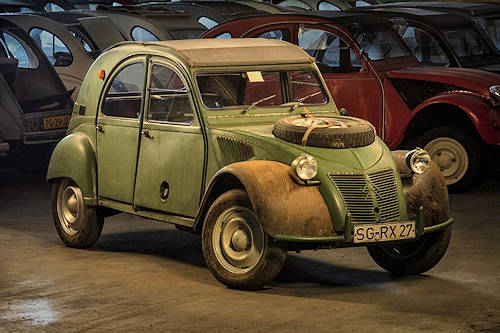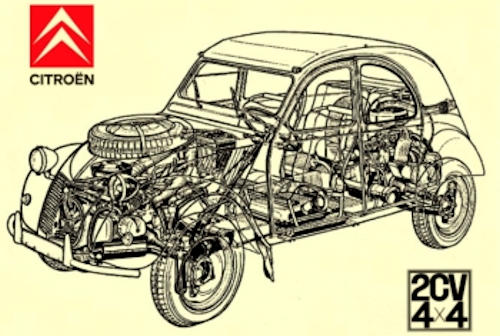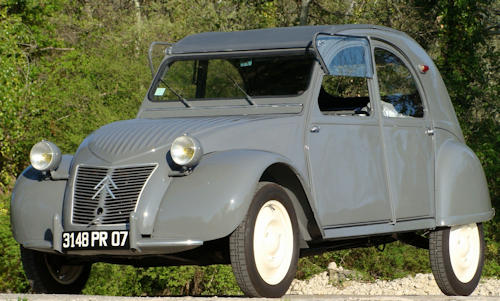Preparing for the news coming from Eurosatory 2022 “The Defense & Security Global Event” which takes place in Paris, it may be interesting to recall the abundant historical French production of military vehicles both on rubber and on tracks.
Among the forerunners, I remember Panhard & Levassor, the oldest French automotive factory, the Nexter industrial group (formerly GIAT Industries) where, among other things, the combat tank is produced. Leclerc o, ACMAT - Ateliers de Construction Mécanique de l'Atlantique -, now part of the Renault Trucks Defense complex which in turn is the head of the Volvo group.
Someone will have already understood that, like our Fiat, also the cousins from beyond the Alps in the last century have diversified their production of vehicles to supply military vehicles during world wars.
Among the companies already mentioned on other occasions there is one in particular worthy of attention, the French icon founded by Andrè Citroën.
The history of the brand

Before describing any model, the history of the characteristic Citroën logo consisting of the two superimposed Vs is curious.
In 1900 the Andrè Citroën factory produced cylindrical gear wheels for industrial and military uses, technically called double helix or bi-helical, but also known as cusp wheels. A feature of these cusp sprockets was the showy circular sequence of V-shaped grooves, a specific engineering detail on the pressure surface between the teeth that inspired the young Andrè. In fact, he used two V-shaped teeth as the brand of the new Citroën which took the name of double chevron, which became the hallmark of the French company founded in June 1919 for the production of vehicles and of the first 10 Hp Type A.
TPV, the myth became 2CV
I bet that the TPV acronym will have inspired in someone the association with a large armored vehicle ...
Cold shower! In reality we are talking about the opposite, that is a peaceful four-seater super light ... (and super sprung) from Citroën, the 2 Cavalli that has been a huge success in sales.
A brief introduction is a must since the 2CV myth was born after the presentation of as many as 250 TPV prototypes, Toute Petite Voiture around 1936.
Well let's face it without delay, the harmless Citroën 2CV seems almost an insult in a column of tactical means, but that's not quite the case.
It is a very light and extremely versatile car with a large standard canvas top, in short, a pure-blooded country car not too far from the prerogatives of the Light Multirole Vehicle; moreover, she has become popular with the public thanks also to the films of Inspector Clouseau.
 Baptised the snail due to its speed of just over 60 km / h and a displacement of 373 cm3, the 2CV o Deux Chevaux, came to life in '48 by adopting the innovative concept of Traction Avant debuted on the French Tracta A in '28 and subsequently becoming Citroën's home in '34.
Baptised the snail due to its speed of just over 60 km / h and a displacement of 373 cm3, the 2CV o Deux Chevaux, came to life in '48 by adopting the innovative concept of Traction Avant debuted on the French Tracta A in '28 and subsequently becoming Citroën's home in '34.
The soft line of the bodywork of the Citroën 2CV and the historic DS as well as the Tracta A they were made by an Italian, the sculptor and designer Flaminio Bertoni (photo).
Only in February 1970 began the production of 2CV models with the 602 cc engine, the same as the Dyane.
The phrase and the engine
The famous phrase that the general manager of Citroën ing. Boulanger asked the chief of the design staff for the construction of the 2 horses:
"I want four wheels under an umbrella, have a car designed that can carry two farmers in clogs and 50 kg of potatoes, or a barrel of wine, at a maximum speed of 60 km / h and with a consumption of 3 liters per 100 km . The suspensions must allow the crossing of a plowed field with a basket of eggs without breaking them, and the car must be suitable for driving a beginner driver and offer indisputable comfort. "

Engineer Maurice Sainturat designed a simple water-cooled 375 cm3 boxer twin engine, although it seems that a reed head with air cooling was subsequently opted for; crank start and a three-speed gearbox completed the more complex mechanical part.
The TPV was to debut as a prototype at the Paris motor show in 40, but the fear that the Wermacht or the SS might overrun the Maginot line showing interest in a spartan and versatile vehicle even militarily, he forced Andrè Citroën to demolish and bury almost all of them. Only at the end of the war did the evolution of the TPV prototype become successful.
The innovative 4x4 Sahara
Its correct name is "Citroën 2CV 4x4 Sahara" and its main feature is the bizarre adoption of two engines, one front and one rear.
The gearbox is a joystick placed in the middle of the seats (and not the traditional one in the center of the dashboard) and its operation is with an insertable tandem that moves the two boxes.
There are two dry single-plate clutches in the respective gearboxes operated by the traditional pedal which compresses a two-way hydraulic piston.

The fuel tanks are under the front seats and the second engine is located in the rear trunk, mirroring the front one.
Aesthetically it is recognizable by the rear fan, a lower line and the spare wheel on the bonnet.
The speed is below 70 km / h and the first engines were those of the traditional 2CV, that is a boxer twin of 375 cm3 which later became 425 cm3 with a power passed from 9 to 12 horsepower.
Truly extraordinary and with excellent feedback, it immediately shows itself without limits on dirt roads or on rough or snow-covered terrain; just think that despite two engines it had a PTT of only 735 kg!
The independent suspensions with oscillating arm per wheel are similar to those of the traditional 2CV but with less travel. The shaped sheet metal body is assembled to the bodywork to reduce weight.
Anyone who has owned at least a Renault 4 (a blasphemy when it comes to Citroën) like myself, will understand well the characteristics of these types of vehicles.

With the 4x4 you could choose which engine / traction to use, which is why it was highly appreciated by the military of the French colonies in Africa and by the geologists in charge of inspecting the oil fields.
Why not a traditional 4x4?
We could trace the versatility of the traditional 2CV substantially to its very limited mass of 560 kg in the most recent versions and to the torque of its twin-cylinder.
Inserting a front transfer case, a transmission shaft, a rear differential, would probably have undermined the sheet metal body which risked deforming with shocks and stresses. If anything, it would have been more logical to use a load-bearing chassis like on the jeeps, but at this point the power-to-weight ratios (and consumption) were getting high, putting the small twin-cylinder in crisis.
This solution probably also forced to review the suspension system with horizontal coil springs contained in an arm.
I believe instead without presumption, but as an enthusiast, that the 4x4 version Sahara it was more of a whim to go a little further, considering that the basic “Traction Avant” versions were already practically small and surprising off-roaders.
 Citroën Méhari Armée, the command post
Citroën Méhari Armée, the command post
Produced by SEAB - Societe d'Exploitation et d'Application des Brevet - on the basis of the 2CV, it is the most military of all, although perhaps it recalls some episode of the film The Pink Panther. It is an evolution of the 2CV with two doors, but often without doors, conceived after studying the consequences of accidents and understanding the usefulness of a less rigid structure, in plastic or better in abs (acrylonitrile butadiene styrene). Here it was nicknamed Spiaggina because it really went everywhere weighing just under the 2CV. However, it offered a payload of 400 kilos and some van / tarpaulin versions were converted and sold for military tasks such as supporting RPG / anti-tank grenade launchers, inspection vehicle or command post. An extremely multi-role vehicle and at the same time Spartan and with no limits of use, which registered 150 thousand units sold in the civil market between '68 and the '80s. It was a great protagonist in the battalions of the Légion étrangère and in the Gendarmerie, also having characteristics of transport / launch aircraft.
The military versions had the electrical system upgraded from 12 to 24 volts (2 12volt batteries) and, due to its lightness and tire section, reduced gears or all-wheel drive were not required.

A very bad press
The newspapers of the period were not very kind with the 2 CV claiming without knowing it that a car could not cost a little more than a pair of horses and therefore much less than other cars.
It was ironically called (in spite of bullying ...) "ugly duckling" for its gray color, or "tin snail" rather than ...
However in '48 against all critics' expectations, the 2CV and its derivatives had an enormous success that amazed Citroën itself.
Just think (source Citroën) that a circular was sent to all dealers so that they could ascertain and accept only buyers who had no real possibility of buying another more expensive model. Waiting times for a brand new 2CV even reached two and a half years.
With the second and last part we will tell other bizarre curiosities in the exciting story of the brand double chevron.
(Continue)
Photo: web












